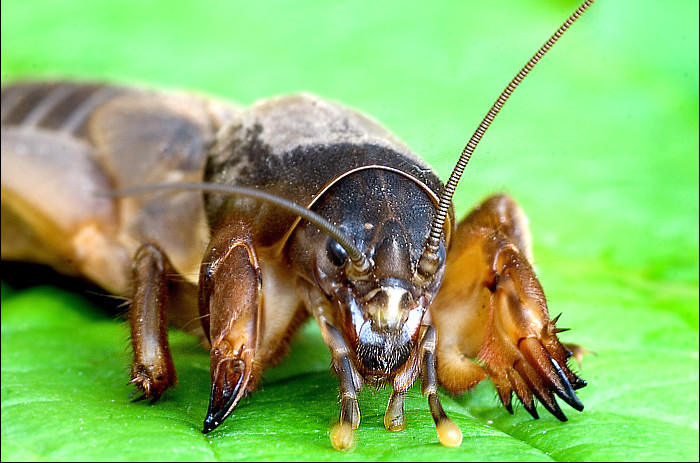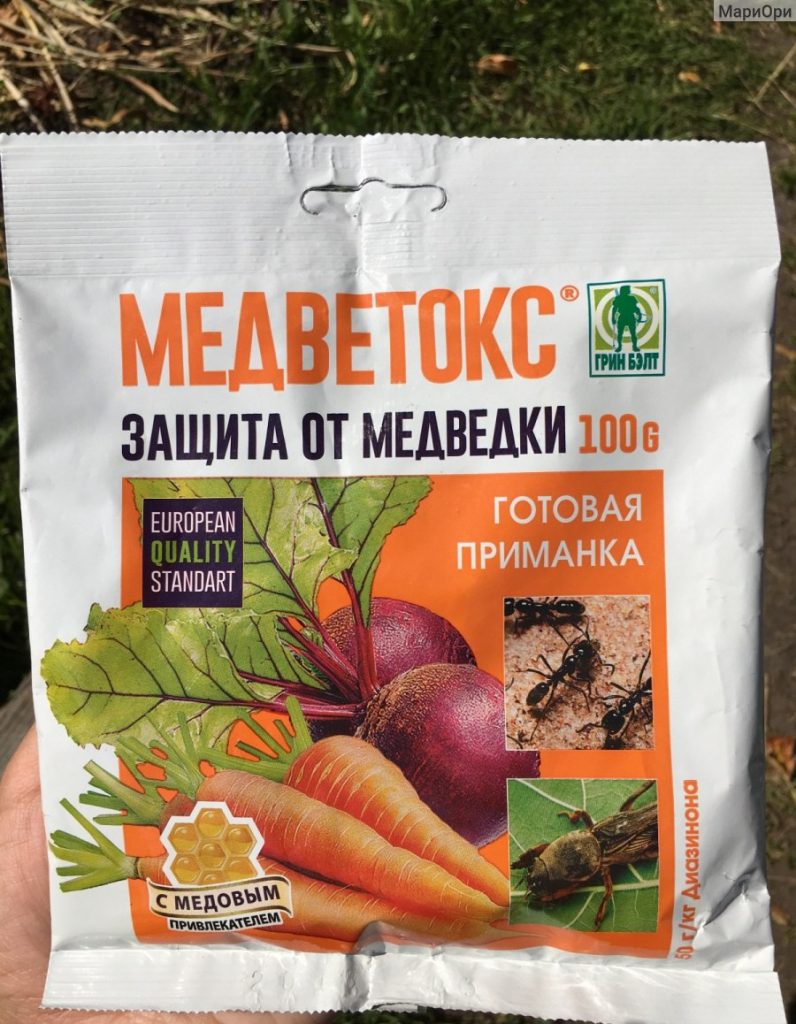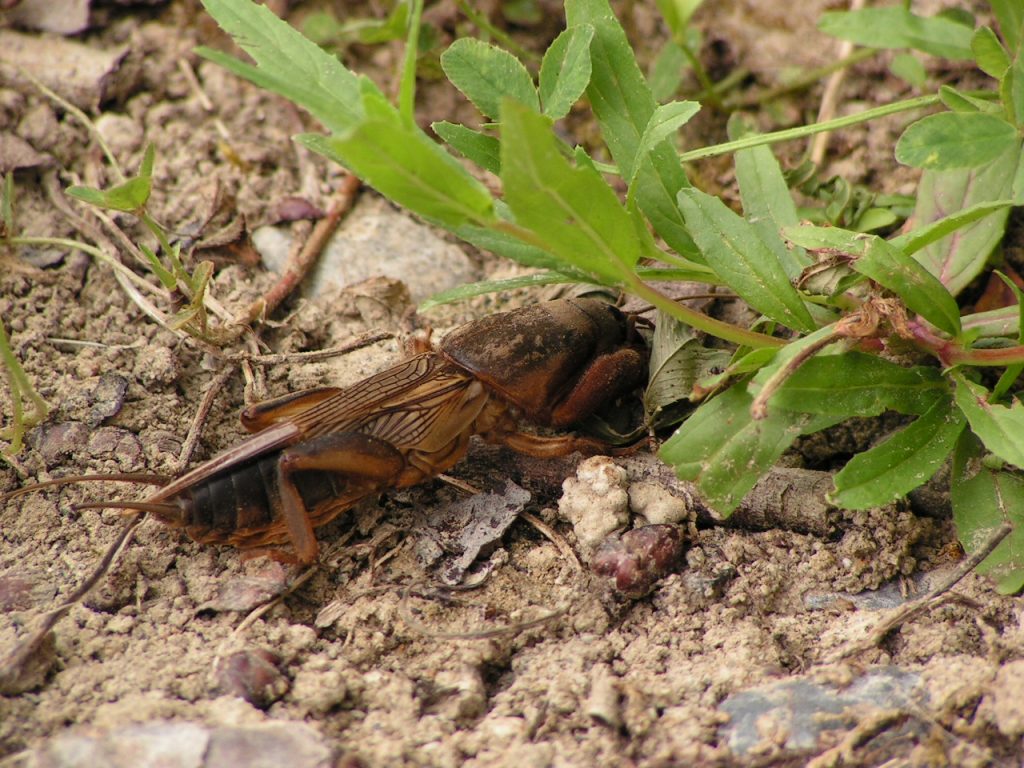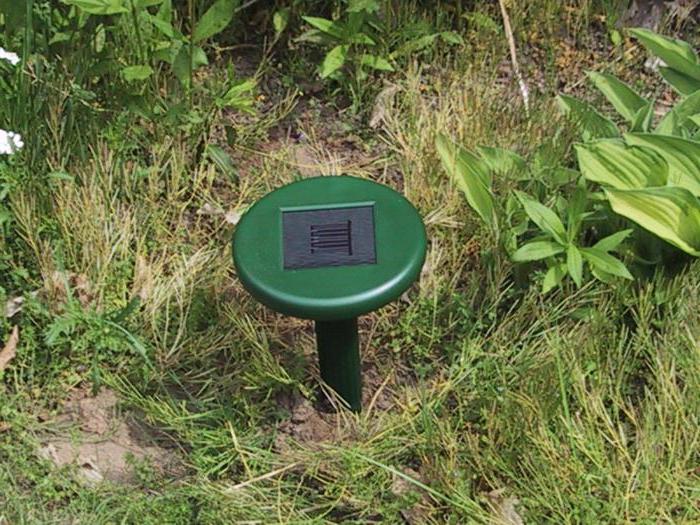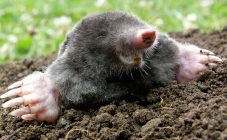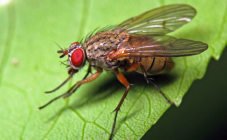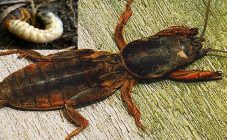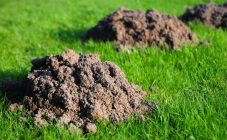Content:
Medvedka is an arthropod insect, so named because of its pubescent brown body. She is large in size, with front clawed paws. The appearance of a bear on the site and the fight against it is a headache for the gardener. The article will tell you how to get rid of this pest in various ways.
Why is the bear dangerous
Popularly, this insect has received several names:
- cabbage, because of the love of cabbage seedlings;
- cricket mole, due to the similarity of body structure and the ability to make similar sounds.
The bear has a hard shell, into which it does not fully pull its head, paws resembling pincers. Outwardly, it looks like cancer. It looks frightening, many, seeing such a monster for the first time, are scared.
The insect is large enough, can reach 5-7 cm in length. It has powerful jaws, crawls underground at a distance of 3-5 cm from the surface and destroys everything that is in its path. The bear has wings, but it can fly only in warm weather. The male is capable of making sounds similar to the sounds of a cricket by rubbing rigid elytra against each other.
On the site appears immediately, as a rule, a pair. They like to settle on fertilized loose soils.
In addition to plant food, they also feed on worms, larvae of May beetles, dragonflies.
Medvedka lives everywhere, except for the northern countries. He loves boggy soil and places with a high groundwater table, loose soil fertilized with cow and horse manure.
If in the spring minks were found in the garden and grooves of loosened earth are visible, then a cricket mole must have settled here. Since the pest causes significant damage to the crop, the owners of the beds have long been fighting this scourge, coming up with new methods against the worst enemy of planting. How to deal with a bear and defeat her by driving her out of the area?
Measures to eliminate the underground enemy must be taken before the first shoots appear, otherwise the gardener will be left without a crop.
Chemical methods of dealing with a bear
How to get rid of a bear on the site? The most effective way is to use Medvetox granules. It is a bait poison, the main substance of which is diazinon. The rest of the ingredients are added for flavor and pest attraction.
The drug is a round red granules. It has several advantages over other poisons:
- 1 pellet kills 1 bear;
- dangerous for bees, but since the drug is placed in the ground, the possibility of their poisoning is minimal;
- safe for earthworms;
- the granules are effective for 21 days.
Instructions for use: along the perimeter of the bed, grooves are made 3-4 cm deep and the poison is poured there. One hundred square meters will require 30 g of substance (1 sachet). Can be spread in rows around plantings. Next, the soil should be leveled, spilled so that the smell spreads better, but not compacted.The results will be visible the next day. If bears live at their summer cottage, in the morning the owners will find them dead. It remains only to burn them.
Or here's another: in the spring you can get a large beet or carrot from the cellar, make several cuts on the skin to enhance the smell. Then plant a root crop to get seeds, and make grooves around, pouring medvetox granules or a mixture of porridge, sunflower oil and any powdered poison for garden pests in a circle.
Medvetox granules can be mixed with a few drops of fragrant sunflower oil and placed inside the burrows.
In the middle of summer, the procedure should be repeated. If the bear managed to lay eggs, then a new generation of plant hunters will appear, which must be neutralized.
Since many of the chemicals used to combat this scourge do not have an attractive smell, they are added to prepared baits.
Poison recipe:
- 0.5 l can of porridge, cooked from any cereal (oatmeal, buckwheat, pearl barley);
- 1 tbsp. a spoonful of sunflower oil with a smell;
- 1 ampoule of the regent.
Mix everything and spread over the holes found on the site. The regent can be replaced with medvegon, karbofos, tornado, thunder or any other poison designed to destroy the Colorado potato beetle and other garden pests. Instead of 1 ampoule, 0.5 tsp of powder is taken.
The ecological drug Rembek, which does not contain chemical poisons, has proven itself well among summer residents. It contains:
- boric acid;
- cereal;
- kerosene;
- sunflower oil;
- sugar.
Appearance: small green granules. Packs of 100 and 200 g.
The drug is laid out in the holes along the laid passages to a depth of 2-5 cm. For every 100 m take 0.5 teaspoon of the poison.
Validity 10-14 days, rain is not terrible for him. If necessary, make the addition again.
Folk ways
Since not everyone wants to use chemistry, gardeners and truck farmers are coming up with new ways to deal with the bear and get rid of it on their backyards.
In this regard, it is possible to pour a solution consisting of 1 liter of water and 100 ml of kerosene into holes and passages. The strong smell and water will make the bear leave the dwelling and go upstairs. You need to catch her immediately so that she does not hide.
Another way to get rid of the pest: pour 1 liter of boiling water over 2 tbsp. onion peel, leave for a day. The concentrated solution is poured into the holes, and the seedlings are watered with diluted water (1: 3) when planting. It is also a top dressing for young plantings. You can also add a crushed clove of garlic to the hole to scare away the bear.
In addition, traps can be set on the site at night. Dig in a cut plastic bottle next to the hole level with the ground, pour some beer into it. You can grease the edges with scented sunflower oil for better attractiveness. Next, it is worth covering it with a board, leaving a small gap so that the bear could climb through, and in the morning to collect a "crop" of pests. But you need to remember that beer quickly deteriorates in the heat, it is recommended to change it once every few days. Similarly, you can make honey traps.
Sometimes the owners use calcium carbide, decomposing it into 5 g burrows and pouring water inside. Moreover, this can be done in rainy weather. The poisonous gas will fill the passages and kill the pest.
Ultrasonic repellers are among the newest methods of fighting underground pests.Their action is to emit waves, which impede the creation of comfortable living conditions for the bear and force them to leave the site.
Ways to deal with a bear in kitchen gardens under the roof
To prevent a dangerous pest from getting into closed greenhouses, grooves should be made along their perimeter, sawdust, sand or ash soaked in kerosene should be laid. But, if the pest has already penetrated there, a number of measures should be taken to exterminate it. For instance:
- dig up the soil;
- make mechanical protection of the root system.
The first way to deal with the bear involves deep digging of the soil by 15-20 cm in both spring and autumn. This helps kill adults and egg clutches.
Another measure to save young plantations from death under film shelters is to place a plant with a lump of earth in a nylon sock or cut old tights and plant it in the ground. The top of the sock should be 4-5 cm above the soil surface. The roots will easily grow through the nylon, and the bear, even if it damages some of the roots, will not be able to completely destroy the plant.
You can plant young seedlings in plastic cut bottles or cups without digging them deep into the ground so that the edges rise above the surface
When planting seedlings under a polycarbonate shelter, it is worth preparing the following solution: take 10 ml of ammonia (ammonia) for 10 liters of water. Pour 0.5 l of this solution into each well. Here, summer residents and gardeners have a double benefit: they scare away a malicious pest with a pungent smell and feed the plants with nitrogen, which is so necessary for their growth and quick survival. The smell of nitrogen quickly disappears, but this is usually enough for the plant to take root, the skin on it becomes coarse, and the pest no longer tastes it.
If you feed the plants with mullein or horse manure, then, on the contrary, it will attract the pest. Instead, you can use chicken, the smell of which the bear does not like.
Other tips for summer residents how to deal with a bear in the garden and win:
- You can stick alder branches into the ground between plantings, changing them every 10-14 days. The pest also doesn't like this smell.
- Before planting seedlings, it is recommended to make grooves in places where adults congregate, to spread poisoned baits with porridge in them, not forgetting about the aisle.
- To scare off a pest with a pungent smell, marigolds, calendula or chrysanthemums can be planted around the perimeter in a polycarbonate greenhouse. The same can be done in the vegetable garden.
- When planting seeds in spring, in order to get the greens to the table early, you can shed the grooves with a solution of iodine (0.5 teaspoon per 10 liters of water).
- Can be spread over the area with spruce or pine branches. Cut and dig some of the needles near the landings, spread the other on top, sprinkling it with earth a little so that the needles do not dry out quickly under the sun. This precaution will not only scare the bear away, but also prevent the cats from digging up the ground with the planted seeds.
Disdainful summer residents can use another method. To scare off the bear with a pungent smell from planting, you can bury the head of a rotten fish in or near the hole, which will later serve as a fertilizer for the soil. Since fetid vapors will penetrate into the air from the ground, this method is best used in open areas.
A few more "old-fashioned" methods
The pest lives in the upper layers of the soil and arranges a nest shallowly for itself, therefore one of their preventive measures will be deep loosening of the earth and thereby destroying insects and larvae.
In addition, in the spring, you can use many other ways to catch the parasite with claws:
- In early spring, when the snow has just melted, summer residents cover the ground with pieces of roofing material, plywood, and thick cardboard.Medvedka crawls out of the ground to warm up under cover. It remains only to collect the parasites and kill.
- In April-May, you can lay out heaps of fresh manure, which heats up quickly in the sun. According to the advice of experienced gardeners, it is better to make them smaller, but lay them out more often, after about 3 m. The pest will climb inside and lay eggs in the warmth. In early summer, the heaps are periodically scanned, killing adult populations and eggs. Some summer residents put a little porridge with poison or a few granules of medvetox under the dung heaps so that the pest immediately perishes.
- You can also bury several 0.5 liter cans, half filled with water, near the dung heaps. At night, the bears will fall into them, but they will not be able to get back out, although they will not drown, since they can swim.
In the fall, until the temperature drops below 8 ° C, gardeners arrange false burrows to catch the cabbage. They dig a hole 50 by 50 cm in size, put a film on the bottom so that the bear that has climbed inside does not crawl below, and put manure inside. Before frosts, when it is already cold enough outside, the formed bag is taken out, disassembled and destroyed by the cricket mole along with its nest. And if a small frost has already hit the street, you can simply scatter manure with a pest and larvae of a bear in the beds - the insect is inactive at low temperatures and freezes.
Many experienced gardeners are familiar with the habits and features of arranging a bear nest. They build their dwellings in a well-lit area at a depth of about 15-20 cm. They can be found by sluggish plants. Medvedka gnaws at them, ensuring uniform heating of the nest. To catch it, it is worth putting on gloves, carefully digging a hole and pulling out a packed earthy lump from it. This is the nest. Then it can be put on a sheet of cardboard or plywood and burned, after pouring it with gasoline.
If you take on board at least a couple of options for dealing with a bear, presented above, and also have patience, then you can easily and simply get rid of the pest in the garden. The main thing is to declare war on the parasite in the spring as early as possible, before the seedlings are planted, so that innocent plants do not suffer on the battlefield.
